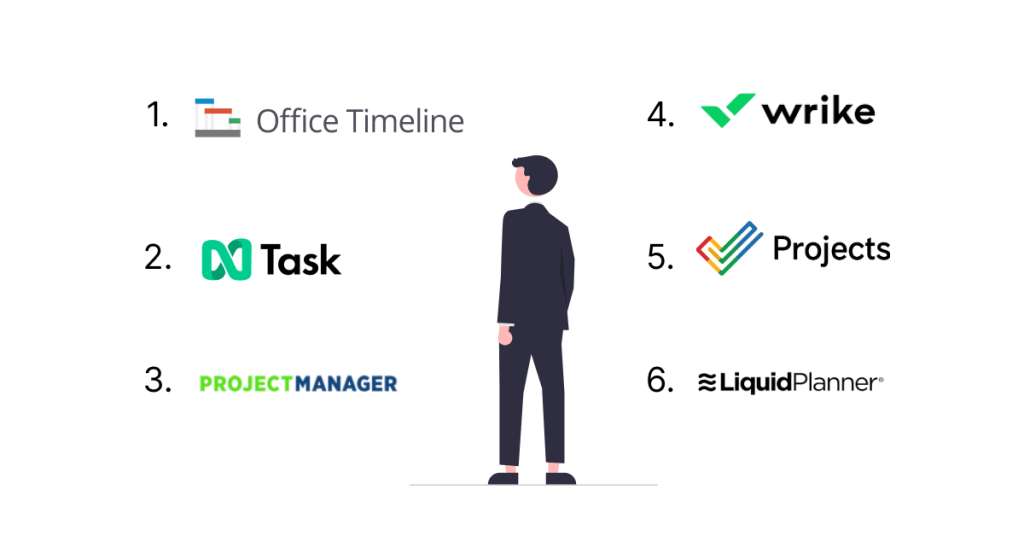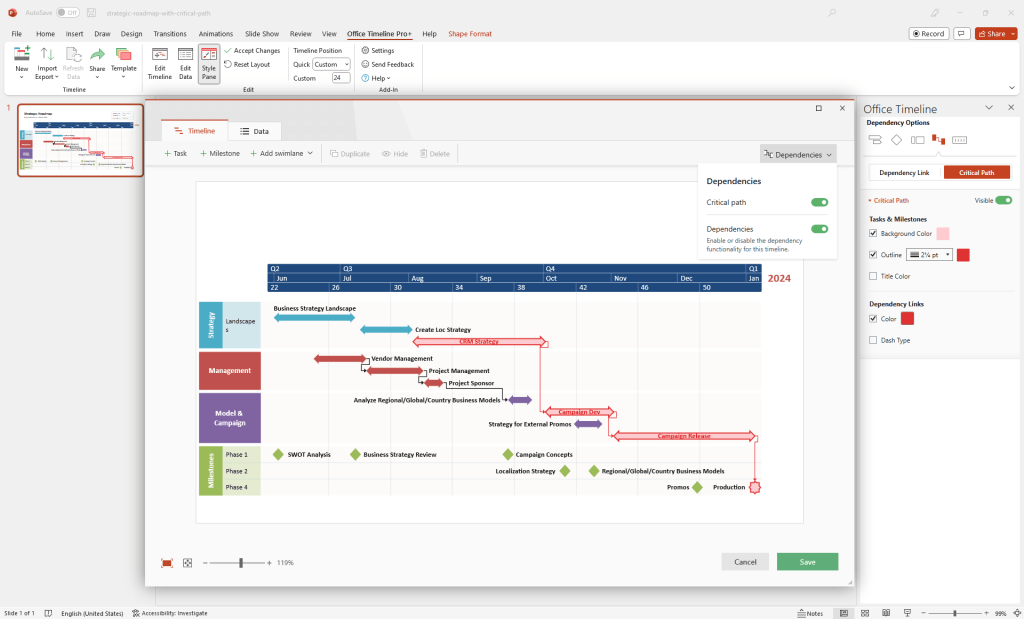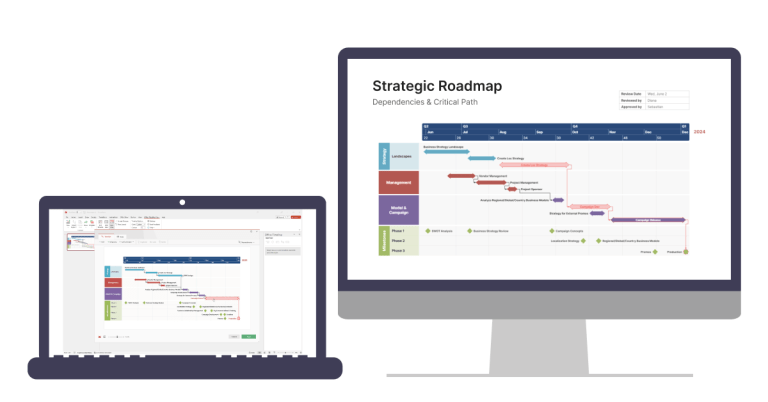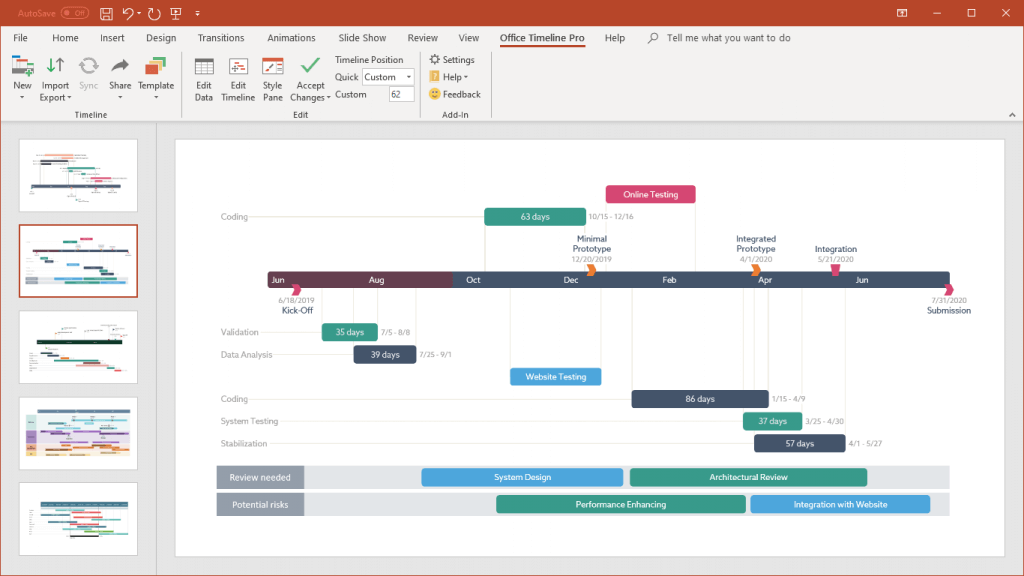
As helpful as critical path analysis has proved to be in project management, the process itself can definitely become a nuisance. Most project managers will agree that manually charting all task details, paying constant attention to due dates, and tracking everything is simply too much sometimes.
Fortunately, there are automated tools that can make identifying a project’s critical path seem a walk in the park.
If your work heavily relies on using the critical path method (CPM) and you are looking for related software solutions, then this blog post is for you. Explaining what critical path software and its benefits are for starters, it then proceeds to curating 6 of the best options available on the market so you can make an informed decision.
What is critical path software?
Critical path software or CPM software refers to dedicated project management programs or apps that allow you to generate critical path diagrams for your project. These tools simplify your work by helping you analyze, schedule, and manage project tasks, dependencies, and resources.
Benefits of critical path analysis software
Here are the main benefits of using purpose-built critical path analysis software:
- Time efficiency – allowing you to input your project data based on which it generates the best route to completing your initiative, an ideal CPM program will significantly reduce the amount of time you spend on determining the critical path manually.
- Visualization – critical path tools offer a high-level display of all the tasks involved in your workflow, thus making it easier for you to identify their status and determine how long it will take to complete each of them.
- Performance tracking – a software system for critical path analysis lets you compare planned start and end dates with the actual ones, helping you monitor the performance of your activities in real time, detect potential delays and avoid bottlenecks.
- Increased efficiency – by saving you time and efforts spent on determining the critical path, CPM tools enable you to redirect your resources towards efficiently scheduling and managing your project’s actual tasks, which speeds up workflows, drives performance, and ultimately improves overall efficiency.
- Enhanced collaboration – quality critical path software offers a centralized view for different project activities and a unified platform that allows various team members collaborate with one another.
Having laid out the advantages of using CPM software at the front, we can now proceed to reviewing a few practical examples of such tools.
What is the best software to use for critical path analysis?
Here is our shortlist of top 6 critical path analysis software solutions to check out:
Let’s have a more detailed look at each of these critical path tools.
1. Office Timeline

Office Timeline is a user-friendly and flexible project planner that helps you generate elegant Gantt charts, timelines, and program roadmaps as native PowerPoint slides.
Key features:
- Task and milestone customization;
- Creating and showing task dependencies;
- Critical path display by the switch of a button;
- Ability to import dependencies from Microsoft Project and Smartsheet;
- Ready-made templates with dependencies;
- Automatic update of schedule based on date changes;
- Task duration, % complete markers, along with Today and Elapsed time indicators;
- Drag&drop functionality to immediately update your plans;
- Show programs with multiple projects or work streams inside a Swimlane;
- Integration with Microsoft Project, Microsoft Excel, Wrike and Smartsheet;
Pricing for the desktop version:
- Pro+ Edition – $199/year;
- full-feature 14-day free trial for the paid version;
- freemium model (with restrictions) available.
2. nTask
With features that range from task management to financial summaries and time tracking, nTask is a project management software solution that has signed up more than 250,000 teams all across the globe.
Key features:
- Gantt chart and Kanban board views for full visibility on workflows;
- Creating and adding tasks, dependencies, assignees, and to-do lists;
- Setting milestones, and planned vs. actual dates;
- Task prioritization with custom statuses;
- Creating and assigning risks and issues;
- Linking issues and meetings with projects;
- Budget management and financial summary reporting;
- Real-time notifications and alerts;
- Third-party integrations.
Pricing:
- Basic plan – available for free forever.
- Premium plan – $3 per user per month.
- Business plan – $8 per user per month.
3. ProjectManager
Our third pick from the list of the best software for critical path analysis is ProjectManager. Equipped with powerful yet simple to use functionalities, such as the ability to drag and drop tasks to create project schedules, this solution can greatly help you change the way you manage your projects.
Key features:
- Timesheets to keep track of the time your team spends on their tasks;
- Critical path calculation algorithm and visualization on Gantt chart;
- Status update alerts for slippage tracking;
- Critical task assignment capability;
- Task filtering by due date, owner, project and more;
- Dashboards for a high-level overview on your project health, time, and workload;
- Task import and export functions;
- Integrations with 1000+ business apps.
Pricing:
- No freemium model.
- Team plan – $13 per user per month.
- Business plan – $24 per user per month.
- 30-day free trial for the Team and Business plans.
4. Wrike
Apart from mainstream project management features, Wrike also offers a suite of advanced customizations with high usability that allow you to personalize your business workflows.
Key features:
- Task creation, adding dependencies and progress tracking functions;
- Gantt chart and Kanban board visualization, along with templates;
- Critical path analysis features to identify bottlenecks;
- Date adjustment functionality;
- MPP, MPX and .XML tasks with duration, dependencies, and resource allocation;
- Multiple project monitoring options;
- Over 400 integrations with third-party applications and programs.
Pricing:
- Free plan – $0 per user per month.
- Professional plan – $9.80 per user per month.
- Business plan – $24.80 per user per month.
5. Zoho Projects
Zoho Projects is a cloud-based project management platform that allows you to plan, track, and collaborate on your project goals in an easy and intuitive manner. Here is what makes is worthy to be featured on our list:
Key features:
- Ability to create and edit four types of task dependencies;
- Critical task identification function;
- Baseline feature to track progress;
- Multiple templates to help you get started faster;
- Color-code system for better organization;
- Task dependency visualization;
- Reminders and notifications;
- Integrations with other apps and tools.
Pricing:
- Free plan – available for individual use.
- Premium plan – $5 per user per month.
- Enterprise plan – $10 per user per month.
6. LiquidPlanner
Allowing you to build efficient plans using predictive scheduling, LiquidPlanner is another great tool for critical path analysis.
Key features:
- Smart schedule bars to clearly indicate task completion time;
- The capability to organize tasks based on status, while keeping the priority status intact;
- Automatic resource leveling;
- Multiple project management through portfolios;
- Data-driven insights;
- Task time-tracking;
- Estimate calculation functions to predict completion dates;
- Task import and export options;
- Predictive scheduling through the addition of target dates.
Pricing:
- Free plan – $0 per user per month.
- Essential plan – $15 per user per month.
- Professional plan – $25 per user per month.
- Ultimate Plan – $35 per user per month.
Conclusion
This was our roundup of some of the best critical path analysis software available on the market. We have tried to make the selection process easy for you by highlighting key features and pricing details for each of the suggested products. Now, all you have to do is analyze your business requirements and decide which solution is the most suitable for you. Use our summary table below:
| Software | Pricing |
1. Office Timeline | Freemium model available Pro+ Edition (for professionals) – $199/year 14-day free trial with full features |
2. nTask  | Basic plan – available for free forever Premium plan – $3 user/month (7-day free trial available) Business plan – $8 user/month (7-day free trial available) |
| 3. ProjectManager | No free plan Team plan – $13 per user/month Business plan – $24 per user/month 30-day free trial for the Team and Business plans |
| 4. Wrike | Free plan – available Professional plan – $9.80 per user per month Business plan – $24.80 per user per month 14-day free trial for paid plans |
5. Zoho Projects  | Free plan – available Premium plan – $5 per user/month Enterprise plan – $10 per user/month 10-day free trial for both paid plans |
6. LiquidPlanner  | Free plan – available Essential plan – $15 per user/month Professional plan – $25 per user/month Ultimate Plan – $35 per user/month 14-day free trial for Ultimate Plan |
FAQs about critical path software
Let’s answer some of the most frequently asked questions related to critical path software.
The software you choose to use to identify a project’s critical path should have the following features:
– Dashboards – they help you gather data from all touchpoints of your project and provide a clear overview of established requirements. This allows you to coordinate and monitor various activities at the same time and get actionable insights regarding your schedule.
– Dependencies – by highlighting the relationship between your tasks, you will be able to clearly determine relevant activity sequences and, thus, better manage the course of action without causing interruptions to your workflow.
– Status tracking and project baselines – this will allow you to compare planned versus actual deadlines, get an accurate idea of the progress made across various tasks in real time, and take action to stay the course on your critical path, if needed.
To discover some concrete examples of such tools, see our top 6 critical path analysis software.
There are six key steps in the process of critical path analysis:
1. Specify each activity of your project.
2. Identify task dependencies to establish activity sequences.
3. Draw network diagram.
4. Estimate task completion time.
5. Identify critical path based on the longest duration of activity sequences.
6. Update the critical path diagram to show progress.
Find out more details and illustrative examples for each of these critical path method steps with our guide on how to identify a project’s critical path.
Microsoft Excel does not have a critical path feature per se. You can, however, use the spreadsheet platform and some custom edits to calculate the critical path for small projects on your own. Here is what you need to do:
1. Create a precedence diagram – on a piece of paper, arrange all your project’s activities (tasks) in the logical order in which they need to occur. Use boxes for tasks and arrows to indicate how they are connected (which activities cannot proceed without another’s output). This sequential flow will give you the structure for your Excel critical path template.
2. Organize your data into an Excel spreadsheet – create three main heading and label them as “Activity List”, “Duration of Activities”, and “Possible Activity Paths”, respectively. Under the first heading, enter the complete list of activities; input the duration of these activities under the second heading, and use the third column to indicate your activity sequences.
3. Identify your project’s critical path – to compute the critical path, which refers to the longest sequence of activities in your precedence diagram, you need to calculate the duration of each individual path identified at Step 2. Use Excel’s SUMPRODUCT function to do this. Once you have the values for each activity path, look for the highest one to determine the critical path of your project.
After you have carried out the steps above, you can start building a Gantt chart to visually represent the schedule for your activities. Jumpstart this process with our easily customizable templates.
Here are the main steps to manually create a CPM diagram or critical path chart:
1. Specify each activity that makes up your project’s work breakdown structure.
2. Identify task dependencies to establish activity sequences.
3. Draw a network diagram using boxes to graphically represent your tasks and arrows to indicate dependencies.
4. Estimate the completion time (duration) for each of your tasks and add these values to the corresponding boxes.
To view a real example of how CPM diagrams look like, check out our guide on how to identify a project’s critical path. Alternatively, you can use critical path software to generate such visuals.

Turn project data into professional timelines
Get the advanced features of Office Timeline Pro+ free for 14 days.
Get free trial